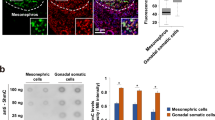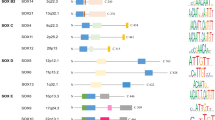Abstract
Sgf29, a component of the SPT-ADA-GCN5 acetyltransferase (SAGA) complex, binds H3K4me2/3 marks and leads to histone H3 acetylation. Previously, we found that downregulation of Sgf29 suppresses c-Myc-mediated malignant transformation. Nonetheless, the upstream regulator of the Sgf29 gene is not yet known. Here, we report that Sry (sex-determining region Y), an HMG (high-mobility group) domain containing transcription factor, directly upregulates Sgf29 gene expression. Sry expression was deregulated in two out of the four tested male rodent hepatocellular carcinoma (rHCC) cell lines. Luciferase reporter and chromatin immunoprecipitation assays indicated that Sry could bind HMG-boxes in the proximal promoter region of the Sgf29 gene. Knockdown of Sry robustly lowered anchorage-independent growth, invasiveness and tumorigenicity of rHCC cells, whereas ectopic expression of Sry conferred more malignant properties. Thus, these data show that Sry is involved in male-specific malignant conversion of rHCCs via Sgf29 upregulation.
This is a preview of subscription content, access via your institution
Access options
Subscribe to this journal
Receive 50 print issues and online access
$259.00 per year
only $5.18 per issue
Buy this article
- Purchase on Springer Link
- Instant access to full article PDF
Prices may be subject to local taxes which are calculated during checkout






Similar content being viewed by others
References
Kaposi- Noval P, Libbrecht L, Woo H, Lee Y-H, Sears NC, Conner EA et al. Central role of c-Myc during malignant conversion in human hepatocarcinogenesis. Cancer Res 2009; 69: 2775–2782.
Amati B, Frank SR, Donjerkovic D, Taubert S . Function of the c-Myc oncoprotein in chromatin remodeling and transcription. Biochim Biophys Acta 2001; 1471: M135–M145.
Lüscher B . Function and regulation of the transcription factors of the Myc/Max/Mad network. Gene 2001; 277: 1–14.
McMahon SB, Van Buskirk HA, Dugan KA, Copeland TD, Cole MD . The novel ATM-related protein TRRAP is an essential cofactor for the c-Myc and E2F oncoproteins. Cell 1998; 94: 363–374.
McMahon SB, Wood MA, Cole MD . The essential cofactor TRRAP recruits the histone acetyltransferase hGCN5 to c-Myc. Mol Cell Biol 2000; 20: 556–562.
Park J, Kunjibettu S, McMahon SB, Cole MD . The ATM-related domain of TRRAP is required for histone acetyltransferase recruitment and Myc-dependent oncogenesis. Genes Dev 2001; 15: 1619–1624.
Lee KK, Workman JL . Histone acetyltransferase complexes: one size doesn’t fit all. Nat Rev Mol Cell Biol 2007; 8: 284–295.
Vermeulen M, Eberl HC, Matarese F, Marks H, Denissov S, Butter F et al. Quantitative interaction proteomics and genome-wide profiling of epigenetic histone marks and their readers. Cell 2010; 142: 967–980.
Bian C, Xu C, Ruan J, Lee KK, Burke TL, Tempel W et al. Sgf29 binds histone H3K4me2/3 and is required for SAGA complex recruitment and histone H3 acetylation. EMBO J 2011; 30: 2829–2842.
Kurabe N, Katagiri K, Komiya Y, Ito R, Sugiyama A, Kawasaki Y et al. Deregulated expression of a novel component of TFTC/STAGA histone acetyltransferase complexes, rat SGF29, in hepatocellular carcinoma: possible implication for the oncogenic potential of c-Myc. Oncogene 2007; 26: 5626–5634.
Lefebvre V, Dumitriu B, Penzo-Mendez A, Han Y, Pallavi B . Control of cell fate and differentiation by Sry-related high-mobility-group box (Sox) transcription factors. Int J Biochem Cell Biol 2007; 39: 2195–2214.
Phillips NB, Jancso-Radek A, Ittah V, Singh R, Chan G, Haas E et al. SRY and human sex determination: the basic tail of the HMG box functions as a kinetic clamp to augment DNA bending. J Mol Biol 2006; 358: 172–192.
Nishino K, Hattori N, Tanaka S, Shiota K . DNA methylation-mediated control of Sry gene expression in mouse gonadal development. J Biol Chem 2004; 279: 22306–22313.
Albrecht KH, Eicher EM . Evidence that Sry is expressed in pre-Sertoli cells and Sertoli and granulosa cells have a common precursor. Dev Biol 2001; 240: 92–107.
Bullejos M, Koopman P . Spatially dynamic expression of Sry in mouse genital ridges. Dev Dyn 2001; 221: 201–205.
Sekido R, Lovell-Badge R . Sex determination involves synergistic action of SRY and SF1 on a specific Sox9 enhancer. Nature 2008; 453: 930–934.
Sugiyama A, Miyagi Y, Komiya Y, Kurabe N, Kitanaka C, Kato N et al. Forced expression of antisense 14-3-3 beta RNA suppresses tumor growth in vivo and vivo. Carcinogenesis 2003; 24: 1549–1559.
Komiya Y, Kurabe N, Katagiri K, Ogawa M, Sugiyama A, Kawasaki Y et al. A novel binding factor of 14-3-3beta functions as a transcriptional repressor and promotes anchorage-independent growth, tumorigenicity, and metastasis. J Biol Chem 2008; 283: 18753–18764.
Mattheews V, Tanaka K, Driacoll J, Ichikawa A, Goldberg A . Involvement of the proteasome in various degaradation processes in mammalian cells. Proc Nat Acad Sci USA 1989; 86: 2597–2601.
Kawasaki Y, Adachi N, Yamazaki T, Todoroki R, Gotou Y, Komiya Y et al. Cancer stem cells in aflatoxin B1-induced rat hepatocellular carcinoma K2 cells. Mycotoxins 2007; 57: 87–93.
Murray JD, Braithwaite AW, Taylor IW, Bellett AJD . Adenovirus-induced alteration of the cell growth cycle: effects of mutation in early regions E1A and E2B. J Virol 1982; 44: 1072–1075.
Katoh H, Ojima H, Saito S, Kondo T, Hosoda F, Imoto I et al. Genetically distinct and clinically relevant classification of hepatocellular carcinoma: putative therapeutic targets. Gastroenterology 2007; 133: 1475–1486.
Iyengar RV, Pawlik CA, Krull EJ, Phelps DA, Burger RA, Harris LC et al. Use of a modified ornithine decarboxylase promoter to achieve efficient c-MYC- or N-MYC-regulated protein expression. Cancer Res 2001; 61: 3045–3052.
Nilsson JA, Keller UB, Baudino TA, Yang C, Norton S, Old JA et al. Targeting ornithine decarboxylase in Myc-induced lymphomagenesis prevents tumor formation. Cancer Cell 2005; 7: 433–444.
Zhang XY, DeSalle LM, Patel JH, Capobianco AJ, Yu D, Thomas-Tikhonenko A et al. Metastasis-associated protein 1 (MTA1) is an essential downstream effector of the c-MYC oncoprotein. Proc Natl Acad Sci USA 2005; 102: 13968–13973.
Palaskas N, Larson SM, Schultz N, Komisopoulou E, Wong J et al. 18F-Fluorodeoxy-glucose positron emission tomography marks Myc-overexpressing human basal-like breast cancers. Cancer Res 2011; 71: 5164–5174.
Liu L, Ulbrich J, WÜstefeld T, Aeberhard L, Kress TR, Muthalagu N et al. Deregulated MYC expression induces dependence upon AMPK-related kinase 5. Nature 2012; 483: 608–612.
Bradford ST, Wilhelm D, Bandiera R, Vidal V, Schedl A, Koopman P . A cell-autonomous role for WT1 in regulating Sry in vivo. Hum Mol Genet 2009; 18: 3429–3438.
Ling S, Chang X, Schultz L, Lee TK, Chaux A, Marchionni L et al. An EGFR-ERK-SOX9 signaling cascade links urothelial development and regeneration to cancer. Cancer Res 2011; 71: 3812–3821.
Thomsen MK, Ambroisine L, Wynn S, Cheah KS, Foster CS et al. SOX9 elevation in the prostate promotes proliferation and cooperates with PTEN loss to drive tumor formation. Cancer Res 2010; 70: 979–987.
Clevers H . The cancer stem cell: premises, promises and challenges. Nat Med 2011; 17: 313–319.
Lapidot T, Sirard C, Vormoor J, Murdoch B, Hoang T, Caceres-Cortes J et al. A cell initiating human acute myeloid leukaemia after transplantation into SCID mice. Nature 1994; 367: 645–648.
Reya T, Morrison SJ, Clarke MF, Weissman IL . Stem cells, cancer, and cancer stem cells. Nature 2001; 414: 105–111.
Mani SA, Guo W, Liao MJ, Eaton EN, Ayyanan A, Zhou AY et al. The epithelial–mesenchymal transition generates cells with properties of stem cells. Cell 2008; 133: 704–715.
Zhou BB, Zhang H, Damelin M, Geles KG, Grindley JC, Dirks PB . Tumour-initiating cells: challenges and opportunities for anticancer drug discovery. Nat Rev Drug Discov 2009; 8: 806–823.
Takahashi K, Yamanaka S . Induction of pluripotent stem cells from mouse embryonic and adult fibroblast cultures by defined factors. Cell 2006; 126: 663–676.
Acknowledgements
We are grateful to K Katagiri for the technical assistance. This work was partly supported by the ‘Academic Frontier’ project for Private University: a matching fund subsidy from MEXT (Ministry of Education, Culture, Sports, Science and Technology), 2006–2010 (to FT) and 2010–2012 (to HA).
Author information
Authors and Affiliations
Corresponding author
Ethics declarations
Competing interests
The authors declare no conflict of interest.
Rights and permissions
About this article
Cite this article
Murakami, S., Chishima, S., Uemoto, H. et al. The male-specific factor Sry harbors an oncogenic function. Oncogene 33, 2978–2986 (2014). https://doi.org/10.1038/onc.2013.262
Received:
Revised:
Accepted:
Published:
Issue Date:
DOI: https://doi.org/10.1038/onc.2013.262



